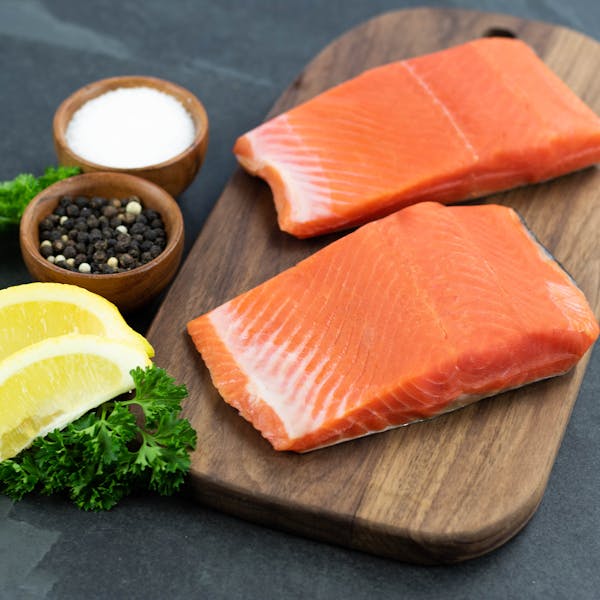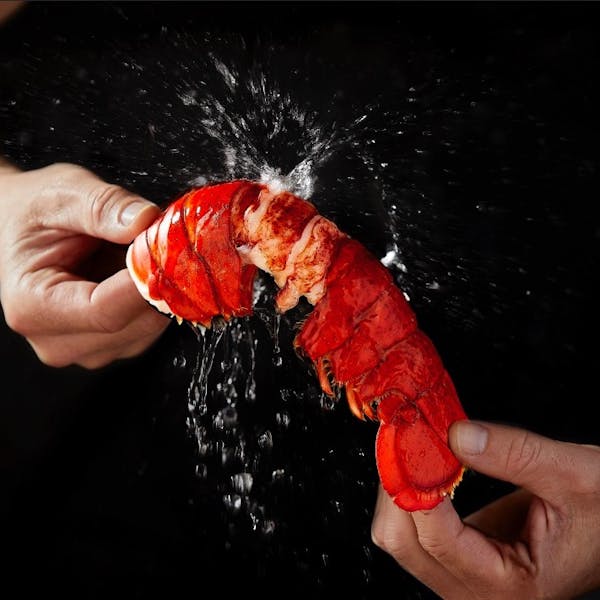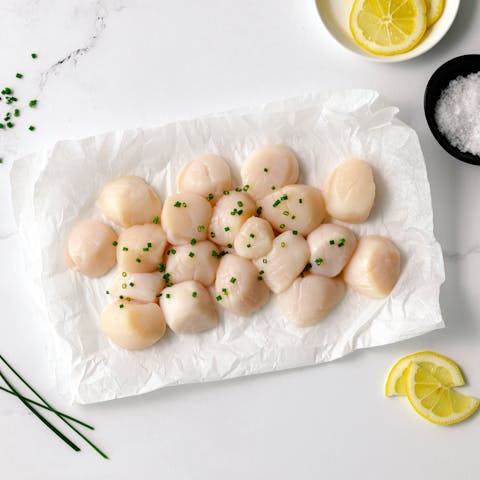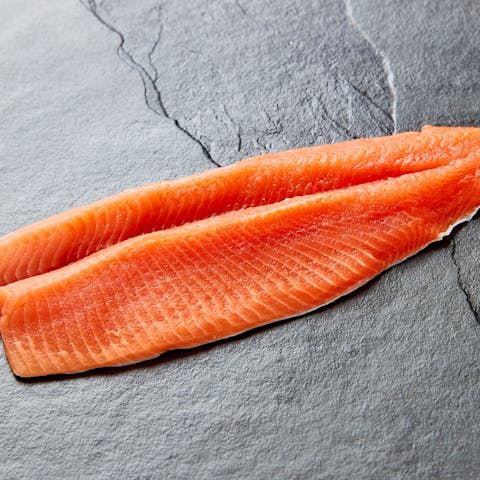

Sustainably harvested, wild caught and responsibly raised from independent fisheries.

Wild Caught Seafood
Direct from boats to your door, our seafood, like panga-fished Mexican blue shrimp and Wild Alaskan Copper River sockeye salmon, is traceable and frozen at peak freshness. Enjoy savory, robust flavors—leaner than farm-raised options.

Sustainable Seafood
Balanced in flavor with higher fat content, sustainable seafood supports ocean health and global demand. Certified by third-party standards like ASC, BAP, GlobalGAP, and Fair Trade for responsible aquaculture practices.

How to Grill Lobster Tail
- Cut each tail down the back to the fins with sharp kitchen sheers
- Use your thumbs to separate the top and bottom of the shell from the meat
- With meat placed on top of the shell, place tails on the grill
- Cook for 1-2 minutes per oz at 400 ℉ or until internal temperature reaches 145℉
- Baste with garlic and herb butter & enjoy!

Many (mistakenly) believe that farm-raised seafood is bad, and wild-caught fish is always the premium product. While there’s some merit to this misconception, this oversimplified message is far from the truth. Farmed fish does sound scary. It’s been associated with public issues in regard to the environment and food safety in the past.

We feel especially lucky to be sourcing from Ready Seafood directly so that our customers can try these extra meaty tails for themselves. Curt Brown and Brendan Ready (cousins, lobstermen, and key leaders at Ready Seafood) graciously showed us their favorite ways to prepare this shellfish favorite on Instagram Live.

Wild Caught Mexican Blue Shrimp from Del Pacifico, the first and only Fair Trade Certified wild shrimp company! Many people associate Fair Trade certification with safe working conditions and fair wages to farmers and workers — which is absolutely a huge part of it — but it goes far beyond the labor side of a product.

In January, I visited the remote island of Frøya in western Norway: population 4,962. It was a many-hours drive from anywhere, just off the coast and beyond the protection of the fjords — home of the PrimeWaters salmon we now offer. It’s salmon raised right, without antibiotics or growth hormones.
Seafood Cooking Guides
Seafood is an excellent source of protein, vitamins, and minerals, and it's also low in fat and calories. The average seafood serving has only about 150 calories and less than 10 grams of fat. Seafood can be prepared in a variety of ways including baking, grilling, barbecuing, frying, and boiling. Popular seafood recipes include Lobster Rolls, Grilled Salmon, and Fish Tacos.
| Seafood Cut | Method | Temp | Avg Time | Finish Temp |
|---|---|---|---|---|
| Fish Fillet | Sear | Med-High | 3-5 mins | 145 °F |
| Shrimp | Sear | Med-High | 3-4 mins | 120-140 °F |
| Crab Legs | Oven | 350 °F | 5-9 mins | 145 °F |
| Lobster | Grill | 425 °F | 9-10 mins | 140 °F |
Note:The above guidelines are only guard rails. Average time depends on size/amount of fish/shellfish. Stoves and pans vary in performance as well; so to achieve perfectly cooked seafood, always check color and texture regularly.
Seafood FAQ
We scour the world to find the most sustainable aquaculture and wild-caught operations that offer delicious seafood with no antibiotics or added chemicals and that operate in a way that is good for the environment.
Aquaculture uses controlled conditions to raise fish, and can be in land-based systems in tanks or in enclosed portions of natural bodies of water. Farm-raised seafood tends to have a milder flavor and higher fat content, which contributes to a more buttery taste and helps it stay moist when cooking.
Wild-caught fish is usually leaner due to its time spent swimming in the ocean, and has more complex flavor components, leaning into richer distinctions. Small boats and small crews catch our wild-caught fish from icy cold waters around the U.S. The fishermen we work with are dedicated to sustainable practices and use the utmost care to minimize bycatch and provide the freshest product.
We suggest either placing your seafood product in the fridge and letting it thaw overnight, or placing the product in a sealed plastic bag and immersing it in cool water.
Defrosting seafood in the fridge can take six to eight hours per pound. For quicker defrosting, place your seafood in a sealed plastic bag and submerge it in a bowl of cool water on your countertop. It should take 1-2 hours to defrost.
In most cases, the chances that you’re eating fish that has never been frozen is extremely rare. Most "fresh fish" these days is previously frozen at some point and then thawed by the time it's at your supermarket. In the seafood business, freezing fish up front is the norm and seals in quality at peak freshness. If it’s frozen properly, like how our trusted seafood partners do it, it actually preserves the quality of the product better than 99% of the “fresh” product on the market today.
You can skip the thawing process and cook frozen fish straight from the freezer. Doing so will add more minutes to total cook time, but you can poach, steam, bake, broil and grill fish straight from the freezer.
To be considered “sustainable”, wild caught fisheries must consider social and economic outcomes for fishing communities, prevent overfishing, rebuild depleted stocks, minimize bycatch and interactions with protected species, and identify and conserve essential fish habitat. Aquaculture, or “farm-raised” seafood is essential to meet increasing demand for seafood throughout the world. Over the past 30 years, global wild-capture fisheries have plateaued while aquaculture has become the fastest growing form of food production worldwide. To be considered a “sustainable” aquaculture operation, farms make every effort to raise healthy animals and go to great lengths to not cause damage to local, natural ecosystems. They avoid using additives, chemicals, hormones, and antibiotics in the feed they provide. “Sustainable” farmers also find ways to utilize the entire animal, whether it be for food (humans and animals), medical applications (think Omega3 pills), or even isinglass, a substance used in some jellies, glues, or for clarifying some beers and wines. Whether farmed or wild-caught, our producers are all third-party certified to ensure their practices are ecologically friendly and on the leading edge of sustainability and food safety.
We get as close to the source as possible to get seafood from our suppliers' boats to your door. From panga-fished Mexican blue shrimp to Wild Alaskan Copper River sockeye salmon, our products are geographically traceable - we can pinpoint on a map where our products come from. We offer traceable, chemical free, and antibiotic free seafood products from reputable suppliers sourced from sustainable wild fisheries around the world.
Frozen seafood is often better than what can be purchased fresh. When handled properly and frozen immediately, the clock stops; our suppliers freeze in the freshness.
Milder in taste than wild fish with a higher fat content, our aquaculture species can be prepared in either the simplest of preparations or as luxurious as you'd like. All of our acuaculture products are certified by third parties including the Aquaculture Stewardship Council (ASC), Best Aquaculture Practices (BAP), Gobal G.A.P. (a trademark and set of standards for good agriculture practices), and Fair Trade. To ensure the long-term health of our oceans and meet global demand, responsible aquaculture is the only path forward. We cannot feed the world on wild-caught alone. Farm-fishing is a great complement to wild fisheries and can help restore environments and wild stocks over time.
Our shrimp tastes and cooks up like shrimp is supposed to. The use of chemicals in the industry can help improve the bottom line of some producers, but at the expense of consumers. We don't sell anything we wouldn't proudly serve our own families. 100% free of chemicals. No Sodium Tripolyphosphates. No Sodium Bisulfites. No surprises.
















